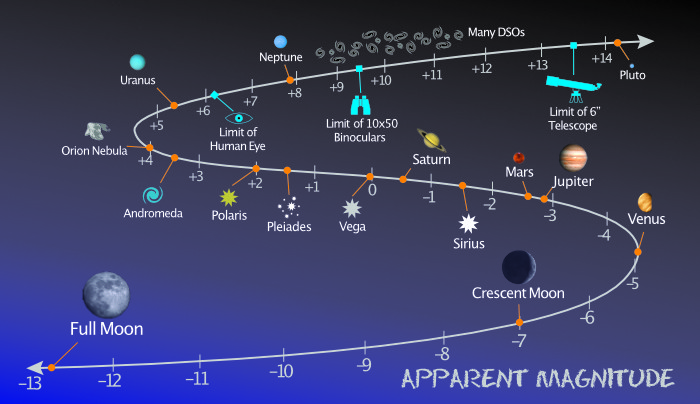 5 Apparent Magnitude - measuring brightness 5 Apparent Magnitude - measuring brightness |
 |
Look up into the night sky and you’ll see a huge range of brightness. On one end is the Full Moon and on the other are countless stars and DSOs (deep space objects) on the edge of visibility. To describe the brightness of an object, stargazers use a number called the apparent magnitude.
The diagram above shows that the apparent magnitude numbers that we use for stargazing range from about -13 to +14. There are some important things to know:
1) The brighter the object, the lower the number. So -1.00 is brighter than +1.00.
2) We always put a - or a + in front of the number. So, we write +1.00, not 1.00.
3) For every five steps, there is exactly a 100x change in brightness, or about 2.512x per step.
As an example, see that Venus is close to -5 and Vega is close to +0. This means that Venus is about 100x brighter than Vega (2.512 x 2.512 x 2.512 x 2.512 x 2.512). Try to figure out how much dimmer Polaris is than Vega. The answer is below.
Notice the cutoffs for naked-eye stargazing, for 10x50 binoculars and a for a 6" telescope. A human eye can see to about -6.00. The binocular lets you see about 3 magnitudes dimmer, or 16x. The telescope lets you see about 7 magnitudes dimmer, or 600x. Yes, optical aid makes a huge difference.
Because of light pollution, there is a cutoff, or limiting magnitude, of what can be seen. In a big city it may be +2.0. In a suburb it may be +4.0. At a dark site, you are only limited by what your eyes, binocular or telescope are capable of. This is why a good location is so important.
You might be wondering why some objects are so much brighter than others. There are two factors involved. First of all, there is the object's luminosity -- how bright it actually is. This is also known as its absolute magnitude. The other factor is distance. The farther the object, the dimmer it will appear. Put these together and you get its apparent magnitude. Betelgeuse in Orion is 200,000 times more luminous than our Sun but is 724 light years away. Its apparent magnitude is +0.0.
There is something important to be aware of about the apparent magnitude of DSOs. A popular DSO, the Andromeda Galaxy, has a magnitude of +3.28. If you were to compare it to a star with the same magnitude, the star would appear way brighter.
Why? It's because DSOs are extended objects — they have length and width — unlike stars that are point source objects that remain as points even when magnified. Apparent magnitude for DSOs measures their brightness as if all their light were squished into a star-like point. So the Andromeda Galaxy would be as bright as that +3.28 star if all its light were in a point.
Just remember that a DSO will appear dimmer than what its magnitude might suggest.
Answer: With a 2 magnitude difference, Polaris is about 6.3x dimmer than Vega. (2.512 x 2.512)
|
|
| Angular Distance ◀️
|



